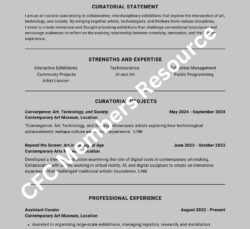
Crafting the Perfect Curatorial CV: Tips and Strategies for Curators
#curator #Curatorial Practices #CV #Jobs #Professional DevelopmentCreating a compelling curatorial CV is an art form in itself. As a curator, your CV is more than just a list of qualifications and experiences—it reflects your curatorial vision and your unique approach to art and culture. In an increasingly competitive field, it’s essential to stand out.
Whether you’re applying for residencies, exhibitions, or jobs at museums and galleries, your CV must demonstrate your expertise in a way that resonates with potential employers. This article will explore key strategies for creating a standout curatorial CV, providing tips, examples, and templates to help you get started.
Highlight Your Curatorial Vision and Approach
Start by including a short profile or statement at the beginning of your CV that encapsulates your approach to curating. This section can be a few lines long but should offer a glimpse into your unique perspective on art and exhibitions. Are you driven by a specific thematic focus, such as post-colonial studies or digital art? Do you prioritize collaborative, community-oriented projects? Use this opportunity to define the core of your curatorial practice.
For example, instead of stating, “Curator with five years of experience in contemporary art,” you could write, “Curator specializing in collaborative, interdisciplinary exhibitions that explore the intersection of art, technology, and society.”
Tailor Your CV to Each Opportunity
While it may be tempting to use a one-size-fits-all CV, customizing it for each application can make all the difference. Different institutions have different priorities, and your CV should reflect that. If you’re applying for a role at a museum with a strong historical focus, emphasize your work with archival materials or your ability to engage with historical narratives in contemporary art. On the other hand, for a residency focused on experimental practices, highlight your innovative projects and any work with emerging artists or unconventional spaces.
Tailoring your CV demonstrates that you understand the institution’s mission and that your skills and experiences align with its needs. A simple way to do this is by adjusting your wording, reorganizing the sections, or highlighting projects matching the job or residency’s focus.
Highlight Your Achievements
In addition to describing your curatorial projects, make sure to quantify your achievements when possible. Curators often work on large, public-facing projects, so showcasing the reach and impact of your exhibitions is key. Include numbers related to audience size, press coverage, or participation in related events like panel discussions or workshops. Did your exhibition receive a particular accolade or review? Mention it. This level of detail not only adds credibility but also helps to demonstrate your ability to engage audiences and contribute to the art world in meaningful ways.
For instance, you could note, “Curated an exhibition on digital futures attended by 5,000 visitors and accompanied by a sold-out symposium with leading figures in the field of new media art.”
Use Clear and Creative Design
While content is king, the design of your CV also matters, particularly in a field like curating that values visual communication. Your CV should be clean and professional, but don’t shy away from incorporating some creativity. Use clear headings and bullet points for easy readability, and ensure that your CV is visually balanced. You could use subtle design elements that reflect your curatorial approach, such as minimalist typography if your practice leans toward contemporary art, or even a muted color palette if you work with historical or archival material.
However, avoid overloading your CV with design elements that may distract from the content. The goal is to present information in a way that is both aesthetically pleasing and easy to navigate.
Physical vs. Digital CVs: Understanding the Differences
In today’s digital age, curators need both physical and digital versions of their CVs. A physical CV is typically used in more formal, in-person contexts, while a digital CV is essential for online applications and networking. The physical version should be clear, concise, and professional, focusing on readability and a traditional format. Conversely, a digital CV offers more opportunities for creativity. You can include hyperlinks to your portfolio, online exhibitions, or press coverage. Digital CVs are also more adaptable, allowing for easy updates and dynamic formats like websites or PDFs with embedded media.
Balancing both formats is key. While a physical CV might still be necessary for interviews or printed applications, a well-designed digital CV can provide more in-depth insights into your curatorial work and is often easier to share across digital platforms.
Resources
- CAA Museum CV Guidelines: Detailed guidelines from the College Art Association, focusing on curatorial positions in museums and institutions.
- CAA Art History CV Guidelines: Guidelines specifically for those working in art history, providing a broader context for curatorial work.
- Museum Careers Blog: Offers tips and experiences from museum professionals, with a focus on building a successful career in curation.
- Resume-Now Curator Templates: Examples and templates for curators, offering inspiration for structuring your CV.
- Harvard Business Review on Museum Curation: An in-depth article exploring what it takes to succeed as a museum curator, including essential skills and strategies.
- Canva: Provides customizable CV templates suitable for both physical and digital use, offering a range of styles from minimalist to creative.
- Cargo: A popular platform for creatives to build digital portfolios and CVs that integrate with their curatorial work and exhibitions.
Summary
Crafting a perfect curatorial CV is about more than just listing your experiences—it’s about weaving together your curatorial philosophy, tailoring your application to each opportunity, showcasing the impact of your work, and presenting it all in a clear, visually engaging format. By following these strategies, you can create a CV that reflects your curatorial vision and helps you stand out in a competitive field.
Download Curatorial CV Template
To help you get started, we’ve prepared a customizable Canva CV template exclusively for our Members. This template is designed to showcase your curatorial experience in a clean, professional format that’s easy to adapt for any opportunity. Members can log in to access the template, and if you’re not a Member yet, take advantage of our free trial to explore this and other valuable resources.

Member Login Please sign in below if you are a returning Call for Curators member.
If you have not yet created your account, please register now and join free for a week. Cancel anytime.This content is restricted to members only.
Photo by Greta Hoffman.







